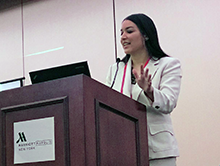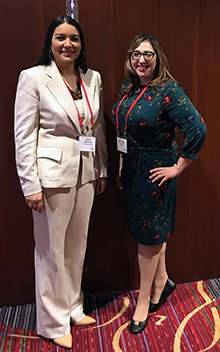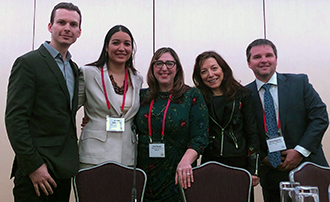
Jessica Spat-Lemus, PhD, Assistant Professor of Clinical Neuropsychology at the Weill Cornell Medicine Brain and Spine Center, was the co-chair of a symposium with Dr. Heidi A. Bender, Director of the Neuropsychological Services at Mount Sinai Epilepsy Center at the February 21, 2019, meeting of the International Neuropsychological Society. The symposium was titled “Biopsychosocial Considerations in the Functional Brain Mapping of Epilepsy Patients: An Intradisciplinary Approach.” Dr. Spat-Lemus’s presentation was titled “Mapping the Melting Pot: Approaches from Clinical Cross-Cultural Neuropsychology.”
The symposium was focused on the need for guiding principles as related to functional brain mapping — an essential part of the surgical planning process — given that the diversification of the United States is outpacing our ability to develop and validate culturally appropriate, psychometrically sound neuropsychological assessments and procedures. Populations that are demographically different than those historically referred for mapping are at an increased susceptibility for unfavorable neurocognitive outcomes.
 Dr. Jessica Spat-Lemus and Dr. Heidi Bender
Dr. Jessica Spat-Lemus and Dr. Heidi BenderThe brain mapping that takes place before neurosurgery in order to identify critical language and motor areas requires special considerations for assessment of diverse populations (i.e., non-native English speaking, bilingual, physical disabilities, reduced educational attainment, pediatric, geriatric). As Dr. Spat-Lemus noted in her presentation, “while the success of brain mapping relies on the careful selection of tests based on putative cortical and subcortical networks and pre-operative neurocognitive assessments, equally as important is consideration of individual patient demographics.”
According to Drs. Bender and Spat-Lemus, patients in populations that are less well studied carry “their own unique experiences, which have the potential to shape the functional distribution within neuroanatomical structures (e.g., shared and unique expressive language areas in bilinguals). For example, supplemental procedures should be considered when mapping territories within Heschl’s gyrus due to its importance in pitch perception in patients who speak tonal languages, such as Thai, in which prosodic changes can confer different word meanings. In an English-language analogy, the difference between preSENT [as in, to present a lecture] vs. PRESent [as in, to give someone a birthday present] may have a dramatic impact on post-operative comprehension difficulties in the patient’s dominant language.”
 Dr. Fedor Panov, Dr. Jessica Spat-Lemus, Dr. Heidi Bender, Dr. Marla Hamberger, and Dr. David Sabsevitz
Dr. Fedor Panov, Dr. Jessica Spat-Lemus, Dr. Heidi Bender, Dr. Marla Hamberger, and Dr. David SabsevitzDrs. Bender and Spat-Lemus, along with their fellow presenters, encouraged an interdisciplinary decision-making approach that includes empirical findings; pairs anatomy-driven tests with novel, innovative tasks; makes modifications based on potential neuroanatomical and experiential differences; and provides an effective time management and unified evaluative approach.
The symposium included three other presenters: neuropsychologists David Sabsevitz, PhD, ABPP, and Marla Hamberger, PhD, and neurosurgeon Fedor Panov, MD.